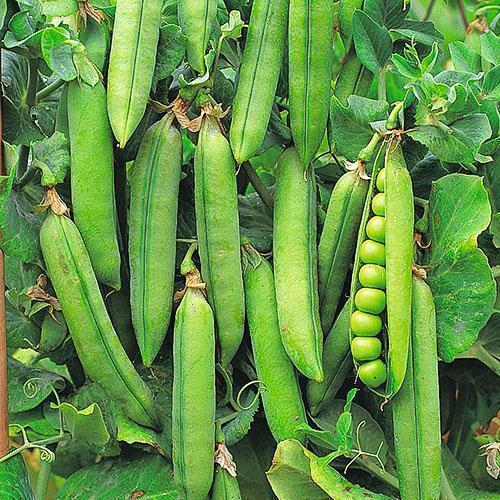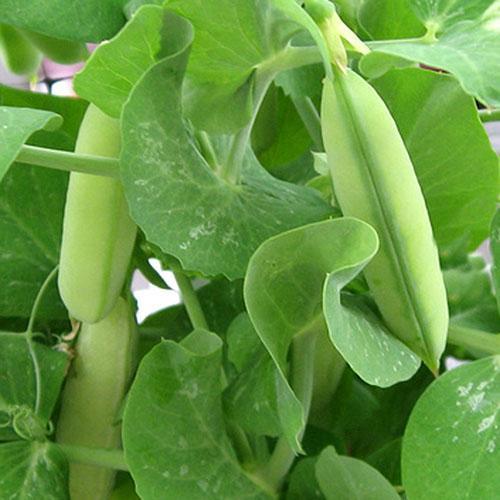The most interesting about peas: from the Stone Age to the present day
 Legumes around the world are considered plants, whose fruits were among the first to be consumed by humans. Already more than 20 thousand years ago, along with wheat, barley and lentils, peas began to be cultivated.
Legumes around the world are considered plants, whose fruits were among the first to be consumed by humans. Already more than 20 thousand years ago, along with wheat, barley and lentils, peas began to be cultivated.
Pea history from the Neolithic to Hellas

The antiquity of peas as an agricultural and food crop is also confirmed by written sources. The story of the use of ground seeds is in the writings of Theophrastus, who lived in the 4th-3rd centuries BC. Pliny also mentions this culture. In China, peas brought here by the Silk Road have been known since the 1st century BC. Of course, ancient seeds differed from modern ones in size, content of nutrients and germination.
The sowing rate of peas in the time of Cicero, whose name is believed to have come from the cicer pea, was many times greater than it is today.
But at the same time, scientists, comparing the archaeological finds of the early periods with the later ones, note that already in antiquity, man learned to conduct primitive hybridization and select the most fertile plants.
Peas on the table of the poor and kings of Europe
 Evidence that speaks of acquaintance with this culture of Europeans dates back to the 7th century. By the Middle Ages, peas had become a massive vegetable garden crop and the food base for the poorest part of the population in many countries. At this time, the plant enters the UK. The most interesting thing is that peas were widely eaten in an already ripe form, such seeds were easier to store, you can grind them to the state of cereals or flour.
Evidence that speaks of acquaintance with this culture of Europeans dates back to the 7th century. By the Middle Ages, peas had become a massive vegetable garden crop and the food base for the poorest part of the population in many countries. At this time, the plant enters the UK. The most interesting thing is that peas were widely eaten in an already ripe form, such seeds were easier to store, you can grind them to the state of cereals or flour.
An unpretentious culture in a country with a rather harsh climate quickly took root and even found itself in the center of the traditions that appeared thanks to it.
For more than half a century, pea shooting competitions have been held in England, and the punishment that arose back in the 17th century, when the culprit is kneeled on dry peas, is known all over the world and is still practiced in some places.
 But the world owes the French the discovery of the taste of green peas. For the first time, a recipe for cooking not ripe, but sugar pea seeds was published in the XIII century. According to legend, Italian delicate peas were first brought to France by Catherine de Medici when she was going to marry Henry II. But before the mass enthusiasm for green peas, another century passed, during which the culture crossed the Atlantic with Columbus, and in 1493 the peas were sown on Isabella Island. Only in the era of Louis XIV, namely on January 18, 1660, juicy seeds of sugar peas were served on the king's table, which fell to the taste of both the monarch and his court.
But the world owes the French the discovery of the taste of green peas. For the first time, a recipe for cooking not ripe, but sugar pea seeds was published in the XIII century. According to legend, Italian delicate peas were first brought to France by Catherine de Medici when she was going to marry Henry II. But before the mass enthusiasm for green peas, another century passed, during which the culture crossed the Atlantic with Columbus, and in 1493 the peas were sown on Isabella Island. Only in the era of Louis XIV, namely on January 18, 1660, juicy seeds of sugar peas were served on the king's table, which fell to the taste of both the monarch and his court.
Russian history of peas
 In Russia, about things long gone, they say that it happened under the Tsar-Pea.Indeed, archaeologists and historians believe that the Slavic tribes from the lower reaches of the Dnieper to Ladoga were well acquainted with peas since ancient times.
In Russia, about things long gone, they say that it happened under the Tsar-Pea.Indeed, archaeologists and historians believe that the Slavic tribes from the lower reaches of the Dnieper to Ladoga were well acquainted with peas since ancient times.
Even the origin of the name of the culture has common roots with the Sanskrit "garshati", which means "to grind". Indeed, in India, and in the countries of the Caucasus, and in Russia, peas were ground, making flour.
The oldest fossilized peas on the banks of the Seversky Donets date back to the 6th – 4th centuries BC. And the first centuries of the new millennium date back to the seeds found near Minsk and Pskov, Yaroslavl and in the forest zone of the Leningrad region. Peas are mentioned in the source of the 11th century, during the reign of Yaroslav the Wise.
Sugar pea seeds in the writings of scientists, the lives of politicians and fairy tales
 Thanks to industrial development from the 17th to the 19th century, peas are widely used as a mass agricultural crop. This amazing plant is of interest not only among peasants, but also among writers and scientists.
Thanks to industrial development from the 17th to the 19th century, peas are widely used as a mass agricultural crop. This amazing plant is of interest not only among peasants, but also among writers and scientists.
The published work of G. Mendel on the general principles of heredity was written on the basis of research on the crossing and cultivation of several generations of peas.
 And in written in 1835 by G.H. Andersen's tale of the search for the true princess, the pea, in fact, became the main character.
And in written in 1835 by G.H. Andersen's tale of the search for the true princess, the pea, in fact, became the main character.
Already in 1906, there were more than 250 varieties of sugar peas in the world, which became extremely popular in the United States and Europe. In Russia, in 1913, under the crops of this culture there were up to a million hectares of arable land. Even curious cases of those years testify to the distribution of peas and its role in crop rotation.
Carried away at the beginning of the nineteenth century in agronomy, US President Thomas Jefferson, among other garden crops, grew many varieties of sugar peas near his home, considering this plant extremely important in human nutrition.
In the vegetable garden still operating in Monticello, you can buy a bag of Prince Albert seeds, which was once grown by the third president.
It is interesting that peas themselves, after such attention from the country's top person, really entered the everyday menu of many Americans. But at the end of the 19th century, peas caused the death of a huge ship. The dry cargo ship that had run over the reefs, into whose hold water poured through the hole, after a while was literally torn apart by the swollen peas that made up the cargo of the ship, like an explosion.
Growing varieties of sugar and shell peas in the world
Until the last century, the lion's share of the world's pea crop consisted of pea cultivars with tough flaps of ripe beans.
Today, the plantings are dominated by sugar varieties of peas, which can be eaten together with a delicate pod, completely devoid of the hard, wax-paper-like layer.
 This was facilitated by the development of technologies for canning and freezing green peas, as well as the possibility of mechanized sowing, watering and harvesting of peas. In terms of the area occupied by shell peas, Canada is now leading, with a monument depicting this plant in the province of Saskatchewan.
This was facilitated by the development of technologies for canning and freezing green peas, as well as the possibility of mechanized sowing, watering and harvesting of peas. In terms of the area occupied by shell peas, Canada is now leading, with a monument depicting this plant in the province of Saskatchewan.
The main global producers of green peas are China and India, the European Union is slightly behind them. In addition to being a valuable food product, peas are also used to make animal feed and starch, proteins and plastics. Modern pea varieties have better yields than before, disease resistance and more germination. Therefore, at lower sowing rates of peas, it is possible to obtain stable yields of both juicy green peas and gourmet sugar beans, as well as varieties for long-term storage and processing into cereals and flour.
Live fertilizer, or what to plant after peas
 But the most interesting thing about peas is that it is able to enrich the soil with nitrogen, which is vital for plants. This amazing property is used in agriculture and home gardens.
But the most interesting thing about peas is that it is able to enrich the soil with nitrogen, which is vital for plants. This amazing property is used in agriculture and home gardens.
After growing peas, up to several tens of grams of nitrogen per meter remains in the zone of the plant's root system.
Up to three crops of peas can be harvested per season, the agricultural technology of which is extremely simple. The green parts of peas are also rich in nitrogen, which makes it possible to grow this type of legume as a green manure and natural fertilizer before, after, and even together with other cultivated plants.
What to plant after peas, what species will benefit from the proximity to this crop? The most interesting thing is that peas as a predecessor in the garden are perfectly perceived by all plants, and carrots, cucumbers, turnips and lettuce, cabbage, potatoes and corn, parsley and many other plants can be adjacent to it without any problems. If you plant sugar pea seeds next to tomatoes, garlic and onions, the plants will suffer from mutual oppression.